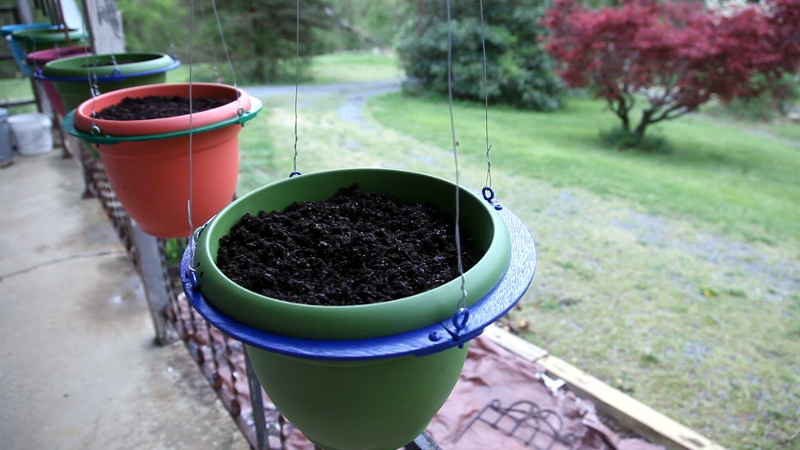With the weather getting a little nicer, [Michael] thought that running some plant hangers off on his CNC router would be a simple stay-at-home project. After all, you just need to cut a couple circles out of a sheet of plywood…right?
Sure, but [Michael] realized that simply cutting out a ring wasn’t a very efficient approach. Unless you happen to need progressively smaller plant hangers, or maybe a new set of drink coasters, the center disc ends up being wasted material. That might not have been a big deal a few months ago, but when a trip to the Home Depot for more plywood could literally be hazardous to your health, that kind of inefficiency just won’t do.
 He reasoned it would be better to break the ring down into sections, which could easily be nested so they fit neatly on a square plywood panel. Of course, now those sections need to be connected to each other in a way that’s strong enough for the ring to hold up the weight of the plant.
He reasoned it would be better to break the ring down into sections, which could easily be nested so they fit neatly on a square plywood panel. Of course, now those sections need to be connected to each other in a way that’s strong enough for the ring to hold up the weight of the plant.
So that means extra pieces need to be cut out to serve as braces, and you’ll need to screw it all together, so better add some nuts and bolts to the BOM. You’ll probably want some eye bolts as well, but in a pinch you could just weld washers to the heads of screws like [Michael] did once he ran out of the good stuff.
Some would argue that the time [Michael] spent coming up with this revised design is more valuable than the wood he avoided wasting, which might be true if he was on the job and getting paid hourly. But when it’s a personal project, and quarantine has made sourcing materials difficult, we think it’s a fantastic example of working with what you’ve got on hand.
















If you multiply what he saves by the number of other people that do the same it adds up to some big material savings and a lot less waste. You can also fit this design on boards so it opens up the different types of materials you can use.
most people who use cad in any way utilize a nesting optimization of some sort and from the looks of the layout it appears he did as well. So if you are cutting this out by hand I agree with you but if anyone is doing it in cad more than likely they are already doing this and saving the material already.
CAD software wouldn’t break the part up for you, which seems to be the main innovation here.
I would have gone with 3 wires per pot instead of 4. Not only would you have more room for watering and weeding between the wires, but 3 ensures a nearly even weight distribution between the wires whereas 4 will put most of the weight on 2 of them and the other 2 will just be balancing it.
I’m curious why Michael didn’t just drill holes in the ridge of the planter and thread the wire through. Is the plastic not sturdy enough or was it for aesthetics?
Yup. Ring from a wire coat hanger and a soldering iron. Perfect until you get frost and need to bring them in.
Drill holes on the plastic container and use J bolt.
Just have a loop on the far end of the wire/rope and use a plant hook when you bring them indoor..
In the real world, the time would only be more valuable if:
a) it was a one off, or small run
b) the cost of the other parts (fasteners) and assembly time cost more than the material saved, and the associated inventory costs (good luck on that. I can order the fasteners prepackaged in small lots for less than the handling cost of the waste circle, much less the extra inventory and additional setup operations), especially since assembly would most likely be by the customer, and I would save on packaging and shipping,as well. Waste also includes the outside of the ring, as well, which is another piece to handle.
c) The material was on hand/available, and would fit in the machine, in the first place
I agree that in a nested situation, full circles is quite likely to be the way to go.
obligatory xkcd
this time with link https://xkcd.com/1205/
Tie a rope (or wire) around the pot, instead of the plywood. Then tie 3 ropes to that rope, going up. It is almost invisible, just as strong and saves you some more screws and paint.
My laser bed is only about 15″x15″ (400 mm x 400 mm), so the size of my parts is limited to that. This project is a great example of how to make much bigger parts by piecing smaller ones together. Often these piecemeal assemblies are stronger, anyway.
….That’s why you 3d print the circles instead.
If you want to completely avoid waste of the source material, grind all the plywood to dust, mix with epoxy and cast the resulting composite into ring molds. Zero waste.
All great ideas, unless if one lives where wind can be a near constant issue. Here outdoor hanging plant pots, would be nothing than a crude wind indicator.